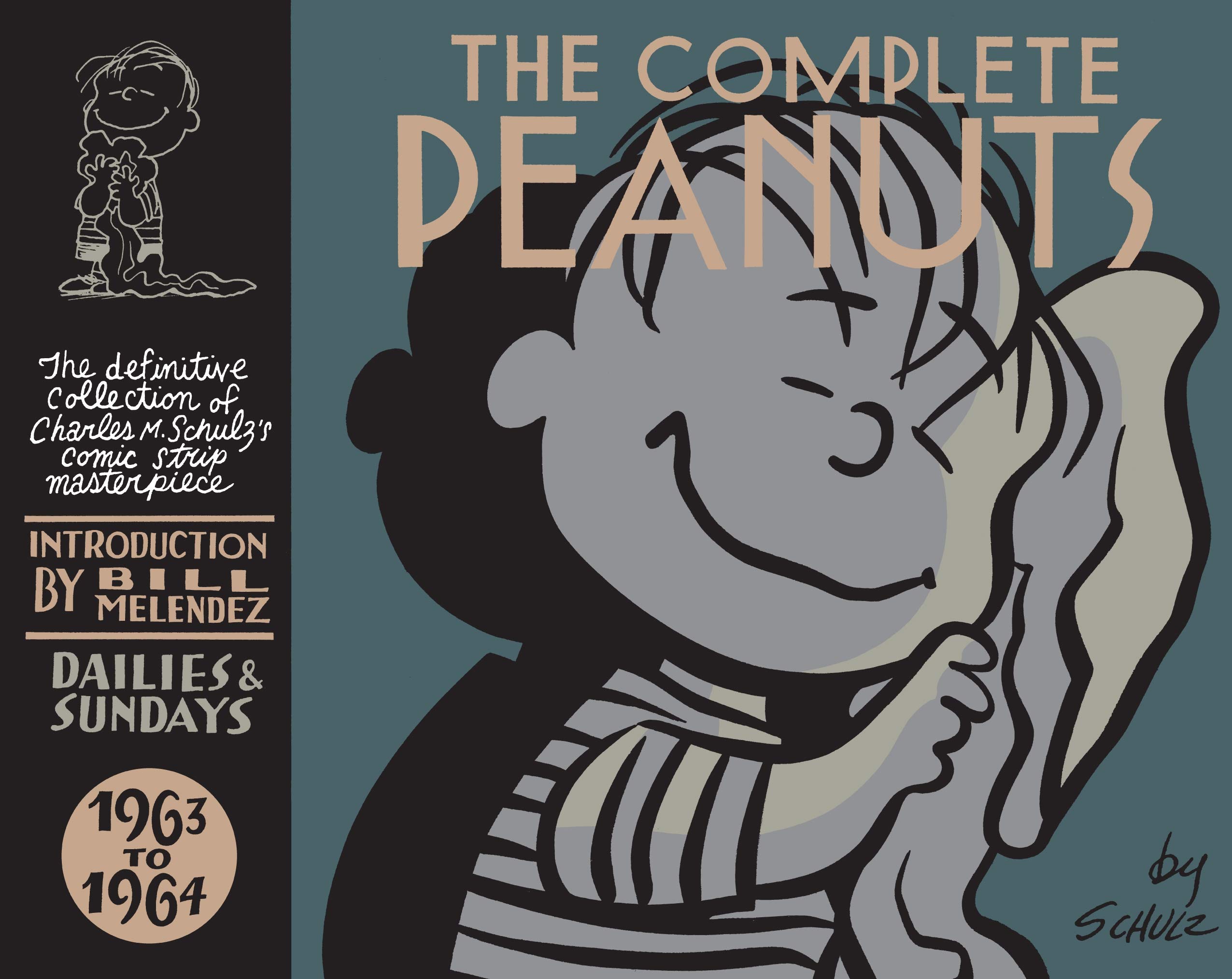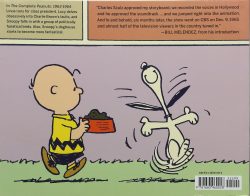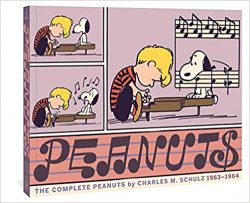


By Charles M. Schulz (Fantagraphics Books/Canongate Books UK)
ISBN: 978-1-56097-723-0 (HB) 978-1683960058 (US PB) 978-1847678140 (UK HB)
Peanuts is unequivocally the most important comic strip in the history of graphic narrative. It is also the most deeply personal. Cartoonist Charles M Schulz crafted his moodily hilarious, hysterically introspective, shockingly philosophical surreal epic for half a century: 17,897 strips from October 2nd 1950 to February 13th 2000. He died from the complications of cancer the day before his last strip was published…
At its height, the strip ran in 2,600 newspapers, translated into 21 languages in 75 countries. Many of those venues are still running perpetual reprints, as they have ever since his death. In his lifetime, book collections, a merchandising mountain and television spin-offs had made the publicity-shy artist a billionaire.
None of that really matters. Peanuts – a title Schulz loathed, but one the syndicate forced upon him – changed the way comics strips were received and perceived: proving cartoon comedy could have edges and nuance as well as pratfalls and punchlines.
Following animator Bill Melendez’s Foreword – relating how he became the TV arm of the Peanuts phenomenon – the timeless episodes of play, peril, psychoanalysis and personal recrimination resume as ever in marvellous monochrome, with more character introductions, plot advancements and the creation of even more traditions we all revere to this day…
As ever our focus is quintessential inspirational loser Charlie Brown who, with increasingly fanciful, high-maintenance mutt Snoopy, remain largely at odds with a bombastic, mercurial supporting cast, all hanging out doing what at first sight seems to be Kids Stuff.
As always, daily gags centre on playing, musical moments, pranks, interpersonal alignments and a seasonal selection of sports, all leavened by agonising teasing, aroused and crushed hopes, the making of baffled observations and occasionally acting a bit too much like grown-ups.
However, with this tome, the themes and tropes that define the series (especially in the wake of those animated TV specials) become mantra-like yet endlessly variable. A consistent theme is Charlie Brown’s inability to fly a kite, and here the never-ending war with wind, gravity and landscape reaches absurdist proportions…
Mean girl Violet, prodigy Schroeder, self-taught psychoanalyst and world dictator-in-waiting Lucy van Pelt, her brilliantly off-kilter little brother Linus and dirt-magnet “Pig-Pen” are fixtures honed to generate joke-routines and gag-sequences around their own foibles, but some early characters – like Shermy and Patty – gradually disappear as new attention-attracting players join the mob. Here that’s thoroughly modern lad “5” and his forward-looking non-conformist family “the 95472s”…
At least Charlie Brown’s existential crisis/responsibility vector/little sister Sally has settled into being just another trigger for relentless self-excoriation. As she grows, pesters librarians, forms opinions and propounds steadfastly authoritarian views, he is increasingly relegated to being her dumber, yet always protective, big brother…
Resigned – almost – to life as an eternal loser singled out by cruel and capricious fate, the Boy Brown is helpless meat in the clutches of openly sadistic Lucy. When not playfully sabotaging his efforts to kick a football, she monetises her spiteful verve via a 5¢ walk-in psychoanalysis booth: ensuring that whether at play, in sports, flying that kite or just brooding, the round-headed kid truly endures the character-building trials of the damned…
At least she’s consistent and equally mean to all. Over these two years, her campaign to curb that weird beagle and cure her brother of his comfort blanket addiction reaches astounding heights and appalling depths – such as when she wins a school science fair by exhibiting Linus as a psychological case study.
This volume opens and closes with many strips riffing on snow, and with Lucy constantly and consistently sucking all the joy out of the white wonder stuff…
Her family ally in the Blanket War is Grandma, but that never-pictured elder’s efforts to decouple Linus from the fabric comforter that sustains him in the worst of times are becoming easier to counter, even as Snoopy’s schemes to swipe the shroud become more elaborate and effective…
Lucy also finds time to master skipping and train others in the wonders of her “jump rope”, but ultimately her unflinchingly high standards lead to accusations of “crabbiness”. The prodigy cannot, however, master the intricacies of kicking a football herself, to the woe of all around her…
Perpetually sabotaged, and facing abuse from every female in his life, Charlie Brown endures fresh hell in the form of smug, attention-seeking Frieda, who demands constant approval for her “naturally curly hair” and champions the cause of shallow good looks over substance. Even noble Snoopy is threatened, as she drags – literally – her boneless, functionally inert but still essentially Feline cat Faron into places where cats just don’t belong. When not annoying the ever-hungry, entertainment-starved beagle, Frieda constantly cajoles the unconventional hound into chasing rabbits like a real dog!
Endless heartbreak ensues once Charlie Brown foolishly lets slip his closet romantic aspirations regarding the “little red-haired girl”: a fascination outrageously exploited by others whenever the boy doesn’t simply sabotage himself…
With great effect, Schulz began assiduously celebrating more calendar occasions as perennial events in the feature: adding Mothers and Fathers’ Days, the Fourth of July and National Dog Week strips to established yearly milestones like Christmas, St. Valentine’s Day, Easter, Halloween/Great Pumpkin Day and Beethoven’s Birthday.
Other notable events include persistent scholastic prevarications and a futile quest to attain that one elusive baseball bubble-gum card for Charlie’s set (Joe Shlabotnik, if you have a spare…), and the gang’s epic and sustained attempt to clean Snoopy’s labyrinthine multistorey doghouse.
At this time, the beagle was growing into the true star of the show, with his primary quest for more and better food playing out against an increasingly baroque inner life, wild encounters with birds, dance marathons, philosophical ruminations, and evermore popular catchphrases. Here, that sense of untrammelled whimsy leads to drama and rabies shots for Snoopy…
Sports injuries play a major role too, with baseball manager/pitcher Charlie Brown benched by “Little Leaguers elbow”, leading to a winning streak for the team. The event also spawns a late diagnosis of “eraserophagia” (nervous chewing of school pencil rubbers). At least the gang gamely rally round, with Linus becoming a lauded sporting superstar of the pitcher’s mound, whilst all and sundry are happy to scream at Charlie whenever he puts a pencil anywhere near his mouth…
The bizarre beagle magnified his strange interior development in all ways. Other than an extended Cold War duel for possession of the cherished comfort blanket, the manic mutt adapted to that darn cat and sundry rabbits but still made time to philosophise, eat, dance like a dervish, stand on his head, converse with falling leaves, play with sprinklers, befriend and battle birds, eat more, stoically brave the elements and discover the potent power of placards and marches…
The Sunday page had debuted on January 6th 1952: a standard half-page slot offering more measured fare than regular 4-panel dailies. Thwarted ambition, sporting failures, explosive frustration – much of it kite-related – and Snoopy’s inner life became the segment’s signature denouements as these weekend wonders afforded Schulz room to be at his most visually imaginative, whimsical and weird…
Particular moments to relish this time involve an increasingly defined, sharply-cornered romantic triangle involving Lucy, Schroeder and Beethoven; Charlie Brown’s backyard camping excursions; copious “pencil-pal” communications; poor penmanship; the power of television and decline of comic books; Lucy’s invention of “immoral” sporting tactics; an outbreak of tree-climbing in advance of the regular autumnal leaf collapse; horrendous rainfall; the growth of avian protest marches; Linus’ mural of the Story of Civilisation and eventual run for School President (with Charlie Brown as Veep!) and a new feature declaring what “Happiness Is…” at the start of each Sunday strip…
To wrap it all up, Gary Groth celebrates and deconstructs the man and his work in ‘Charles M. Schulz: 1922 to 2000’, preceded by a copious ‘Index’ offering instant access to favourite scenes you’d like to see again…
Readily available in hardcover, paperback and digital editions, this volume guarantees total enjoyment: comedy gold and social glue metamorphosing into an epic of spellbinding graphic mastery that still adds joy to billions of lives, and continues to make new fans and devotees long after its maker’s passing.
The Complete Peanuts © 2007, United Features Syndicate, Ltd. 2014 Peanuts Worldwide, LLC. The Foreword is © 2006, Bill Melendez. “Charles M. Schulz: 1922 to 2000” © 2007 Gary Groth. All rights reserved.
